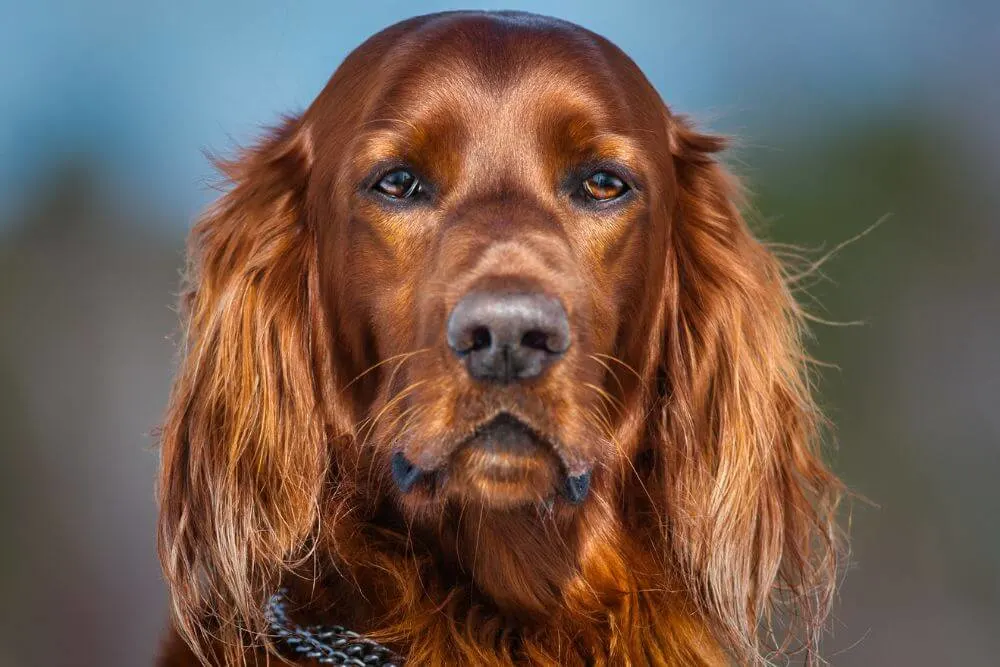
Table of Contents
- 1 What is an Irish Setter?
- 2 What is the difference between an Irish Setter and an Irish Red Setter?
- 3 Facts about the Irish Setter
- 4 Irish Setter Breed Characteristics
- 5 Irish Setter Maintenance
- 6 How long do Irish Setters live for?
- 7 Are Irish Setters healthy?
- 8 What do Irish Setters eat?
- 9 How much exercise do Irish Setters need?
- 10 Irish Setters Temperament and Personality
- 11 Are Irish Setters rare?
- 12 Irish Setter Breed Clubs
- 13 Irish Setter Breeders
- 14 The History of the Irish Setter
- 15 Native Irish Dog Breeds
What is an Irish Setter?
An Irish Setter is a recognized breed of gundog that was bred to help hunters locate and catch game birds in Ireland.
While it is a skilled hunting dog, it is also a loveable, energetic family pet.
This breed is known for its eye-catching rich mahogany or dark chestnut colored silky coat and is possibly the most popular of all native Irish Dog Breeds.
What is the difference between an Irish Setter and an Irish Red Setter?
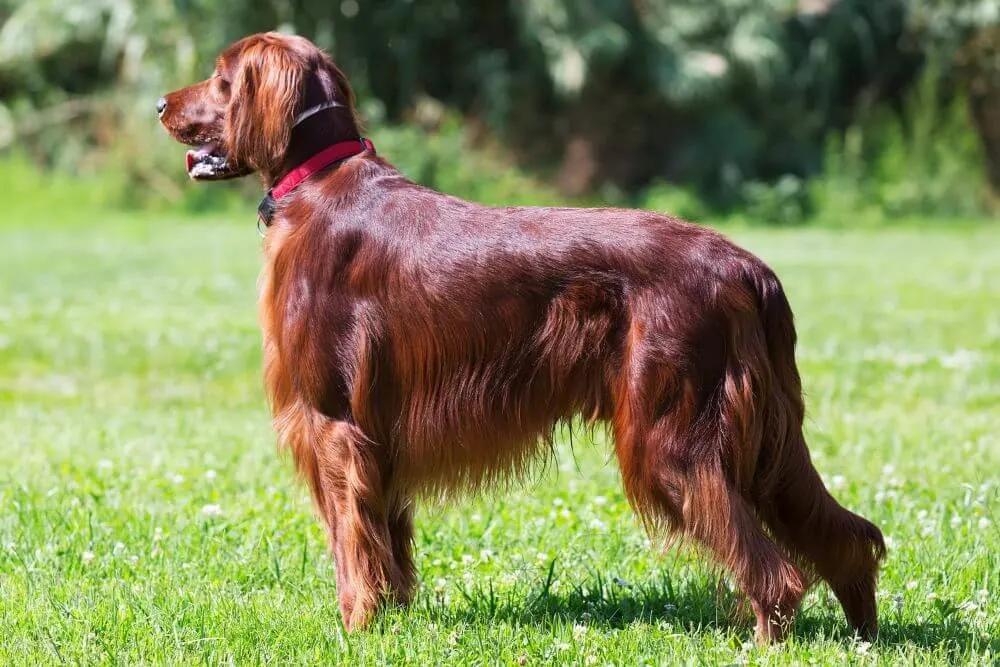
There is no difference between the types of setter described as an Irish Setter (in Irish: sotar rua) and an Irish Red Setter. It is only a difference in name.
Up until the mid-19th century, the term Irish Setter was used in a broad manner to refer to solid red, mostly white, as well as red and white setters from Ireland.
As the popularity of the solid red setter grew considerably from about the 1870s onwards, this breed became known as the Irish Red Setter.
It is recognized by the American Kennel Club as the Irish Setter.
Is an Irish Setter the same as a Red Setter?
Breeders have typically focused on the aesthetics of the Irish Setter breed rather than its abilities in the field, which they were once famed for.
In an effort to reestablish the hunting skills in this breed, some Irish Setters have selectively been bred with English Pointers, English Setters and Brittany Spaniels.
They were then bred again with pure pedigree Irish Setter dogs over 5 generations. These dogs are known as Red Setters.
While they are still considered to be Irish Setters by the Field Dog Stud Book, this slight difference in the name helps to differentiate them from the Irish Setter dogs bred for show.
Irish Red and White Setter
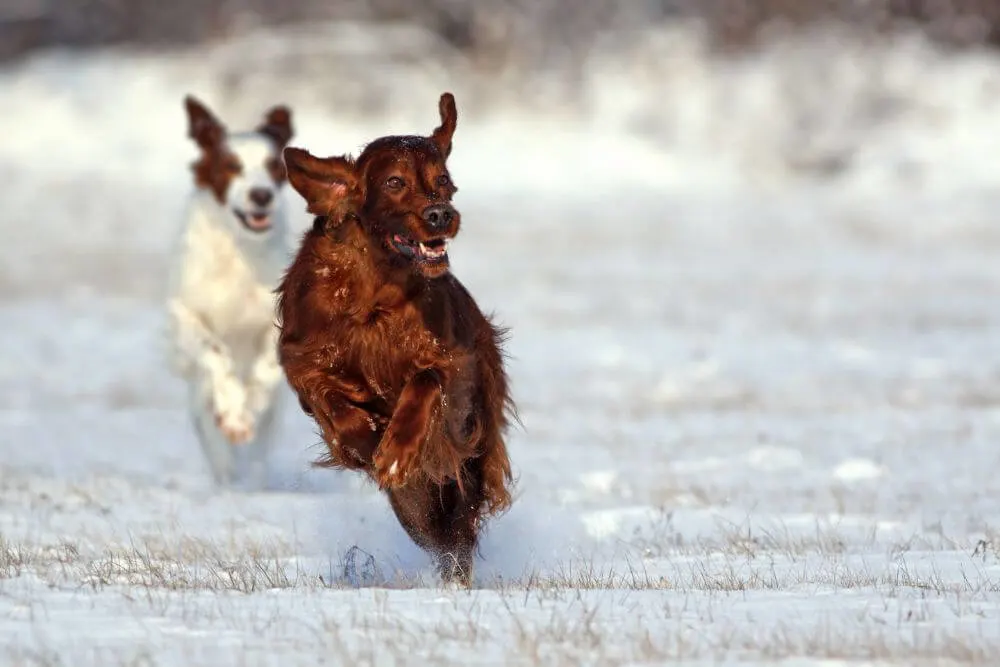
The ancestor of the Irish Setter, the Irish Red and White Setter has been recognized in the more recent past as another unique Irish dog breed.
Facts about the Irish Setter
- The popularity of this elegant looking dog breed grew hugely after its appearance in several dog shows in the 1870s and its rise had the knock-on effect of almost causing the extinction of its ancestor the Irish Red and White Setter
- This popular dog breed has been the breed of choice for many famous people including President Nixon and President Truman of the United States of America
- Henry Gross wrote the famous hit song “Shannon” about the death of an Irish Setter that had belonged to Carl Wilson of the Beach Boys
- Featured in the Disney movie, Big Red, from 1962
- Ireland’s national bus company, Bus Éireann, uses an image of an Irish Setter as its logo. (The dog breed is known for its swift footedness.)
Irish Setter Breed Characteristics
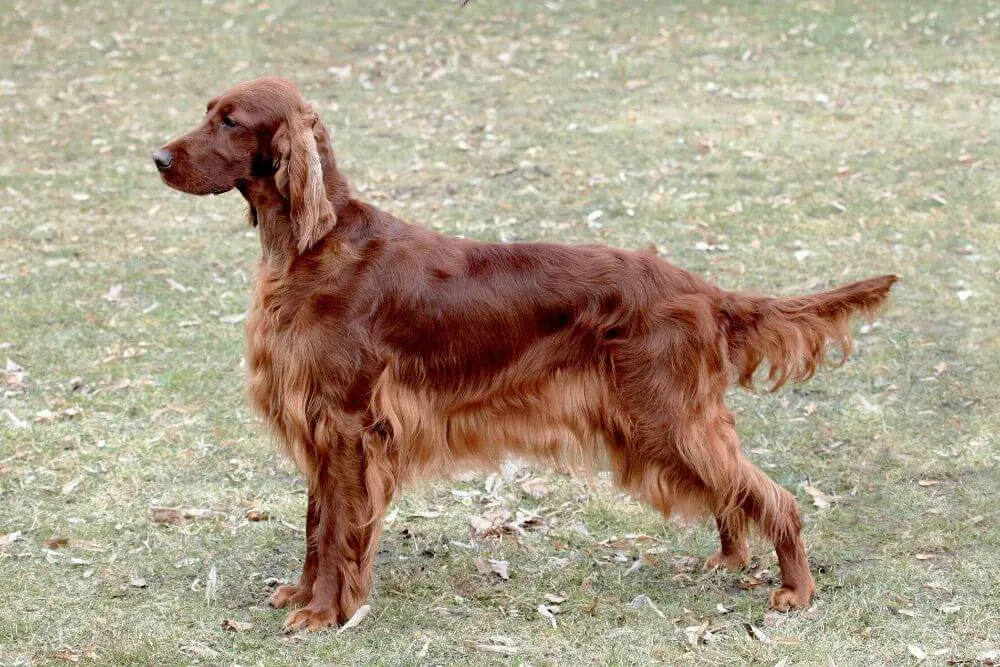
How tall is an Irish Setter?
Irish Setters are medium-sized, lean dogs. Male Irish Setters are between 58-67 cm (23-26.5 inches) at the withers, while females are smaller ranging from 55-62 cm (21.5-24.5 inches).
How much does an Irish Setter weigh?
Male Irish Setters generally weigh in the range of 29-34 kg (65-75 lbs). As well as being smaller, females are lighter and a normal healthy individual does not weigh more than about 29 kg (65 lbs).
The working Red Setters are considerably lighter than the show dogs and typically weigh about 20 kg.
What does an Irish Setter look like?
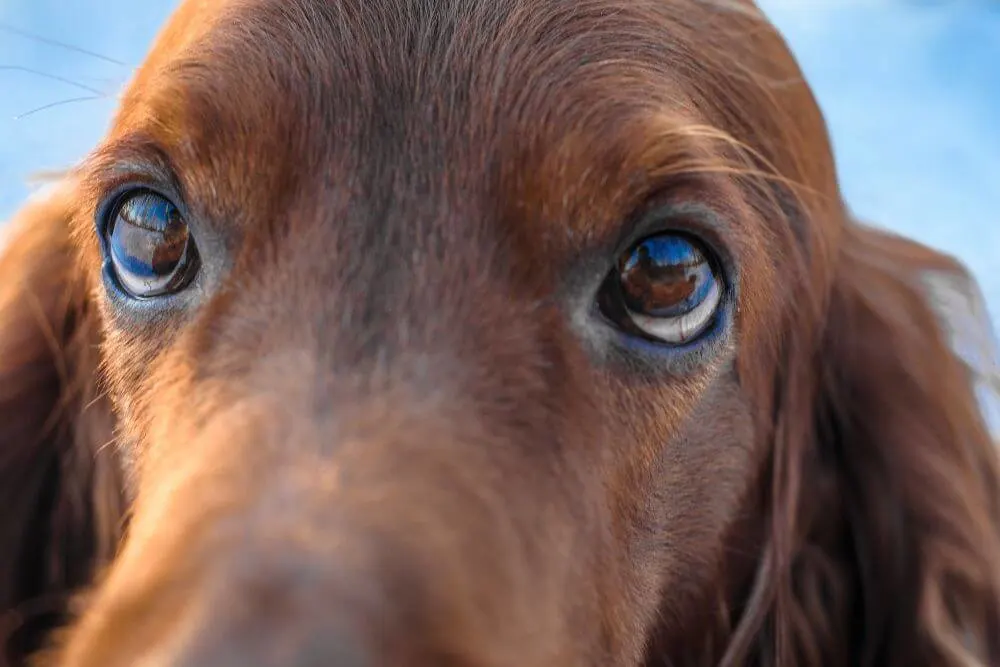
Irish Setters are one of the most striking of all the Irish dog breeds.
This dog certainly makes an impression as it stands tall and slender, with a flowing silky chestnut or mahogany colored coat. The hair is moderately long usually and straight.
Typically, the Irish Setter show dogs have darker color coats than the working Red Setter dogs. Occasionally, small patches of white can be seen on the chest, feet or even muzzle. The body, legs, and long tail are feathered.
Irish Setters have narrow heads, long necks and deep chests. Their brown eyes show their sensitivity and intelligence, as well as always being alert. Low hung ears frame their faces.
What dogs are similar to an Irish Setter?
There are clear similarities between the Irish Setter and the Irish Red and White Setter.
Typically, the Irish Red and White Setter is a bit smaller and more sturdy than the Irish Setter who tends to be more long limbed and streamlined looking.
Although the origins of this breed are not known exactly, there is also likely to be some ancestry from English Setters and Gordon Setters and potentially English Pointers and spaniels as well.
The Irish Doodle is a relatively recent hybrid or designer dog that is an Irish Setter mix, typically between an Irish Setter and a Standard Poodle or miniature Poodle.
Irish Setter Maintenance
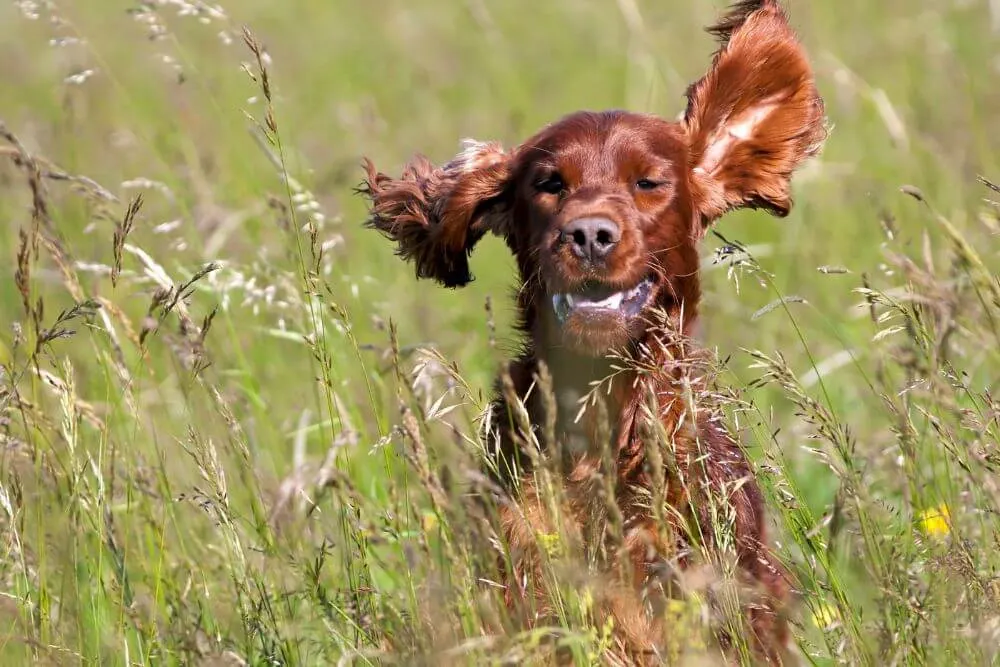
Irish Setters need moderate amounts of maintenance and this should be a consideration for anyone who would like to own an Irish Setter dog.
In addition to the usual nail trimming maintenance that should occur about every two weeks, Irish Setters should also regularly have their teeth brushed using a specially formulated toothpaste for canines.
As their ears hang low, dirt and moisture can get trapped and cause an increased chance of infections or other issues.
The ears of Irish Setters should be checked every week to make sure that there are no signs of infections and the hair should be trimmed if necessary.
Do Irish Setters need much grooming?
In order to make sure that the coat of the Irish Setter stays in prime condition, regular grooming is necessary.
Roughly 2-3 times a week an Irish Setter should get a thorough brushing to remove dead hair and debris. In winter, when the coat is thicker, the frequency of brushing may need to be increased.
The long feathered sections of hair on the legs, body and tail can often get tangled and all knots should be carefully worked out.
Depending on the length of the feathered hair and the activities that the dog does, it might be necessary to trim the hair occasionally to keep the grooming regime more manageable.
Do Irish Setters shed a lot?
Irish Setters are typically average shedders. To avoid excessive Irish Setter shedding, dogs should be brushed a few times a week as then they tend not to leave excessive amounts of hair around the house.
How often should you bathe an Irish Setter?
Bathing a dog too frequently can result in skin irritations, so it is advisable to only bathe every 2-3 months, if possible.
There may be occasions where it is necessary to bathe more frequently, but this should be kept to a minimum. It is always advised to follow the instructions on the dog friendly shampoo to get the best results.
Is the coat of the Irish Setter hypoallergenic?
No, the coat of the Irish Setter is not considered to be hypoallergenic, so if you are one of the unlucky ones to suffer from allergies, then this is not the dog for you.
(One Irish dog breed that is hypoallergenic is the Irish Water Spaniel. The curly hair of this water dog does not usually cause issues for people with allergies.)
Ask your medical professional or veterinary specialist for help to select a suitable breed for your needs.
Do Irish Setters drool a lot?
While Irish Setters are known to drool a little from time to time, it is not usually to an excessive degree. If you have any concerns about your dog, you should get the animal checked by a vet.
How long do Irish Setters live for?
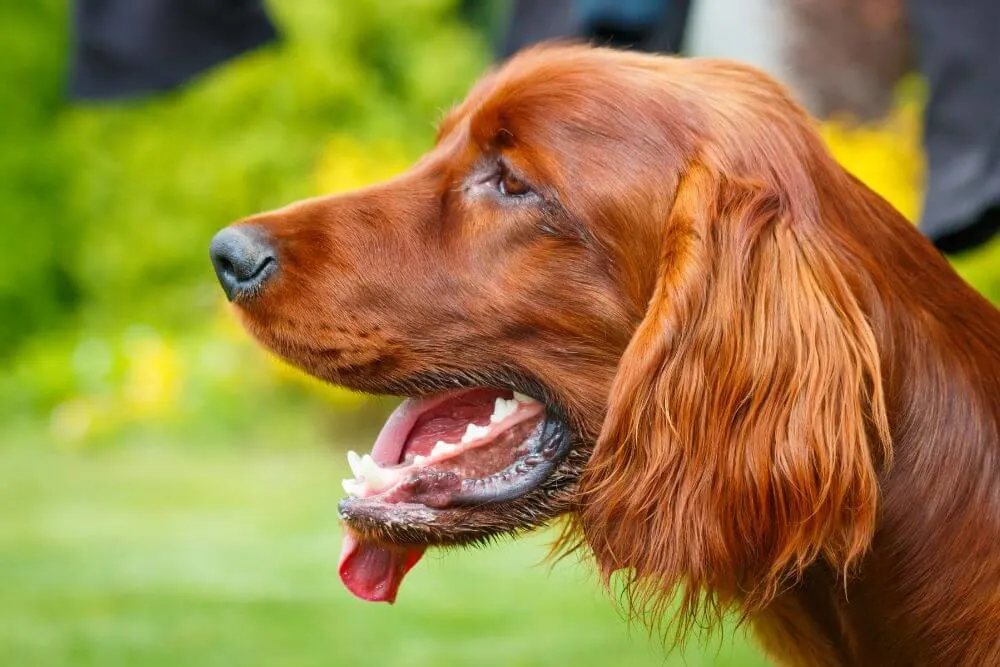
The average Irish Setter lifespan is between 12-14 years. Some individual dogs can live to be a little older, but most people consider 15 years to be very old for an Irish Setter.
At what age do Irish Setters calm down?
Irish Setters are known for their high energy levels.
They retain much of this energy and puppy-like behavior for roughly two years, and occasionally longer in some cases.
This is why it is imperative to start to train your dog at a very early age to ensure that it learns the desired behaviors from the beginning. It will make your life a lot easier!
Are Irish Setters healthy?
Irish Setters are healthy dogs, but do tend to suffer from some ailments.
One of the main issues is bloat and gastric torsion.
This can come on very quickly and without prompt medical intervention can be fatal. (It is best to avoid exercise or intense play before or shortly after meals to reduce the risk of this occuring.)
Other concerns for this breed include eye issues such as progressive retinal atrophy (PRA) and cataracts, as well as hip dysplasia and epilepsy.
Hypothyroidism and in particular bone cancer can also be health problems for this breed. Occasionally canine leukocyte adhesion deficiency (CLAD) can also be a problem.
Some Irish Setters have food allergies, especially towards gluten.
Frequent diarrhea is one sign that all is not well in your dog’s digestive system. If this is the case, seek professional opinion on this.
Obesity is another health problem that can be avoided by ensuring that the dog has the right amount of exercise and nutritious food every day.
Tip: Make sure you talk to your vet about pet insurance to see what coverage is best for your dog.
What do Irish Setters eat?
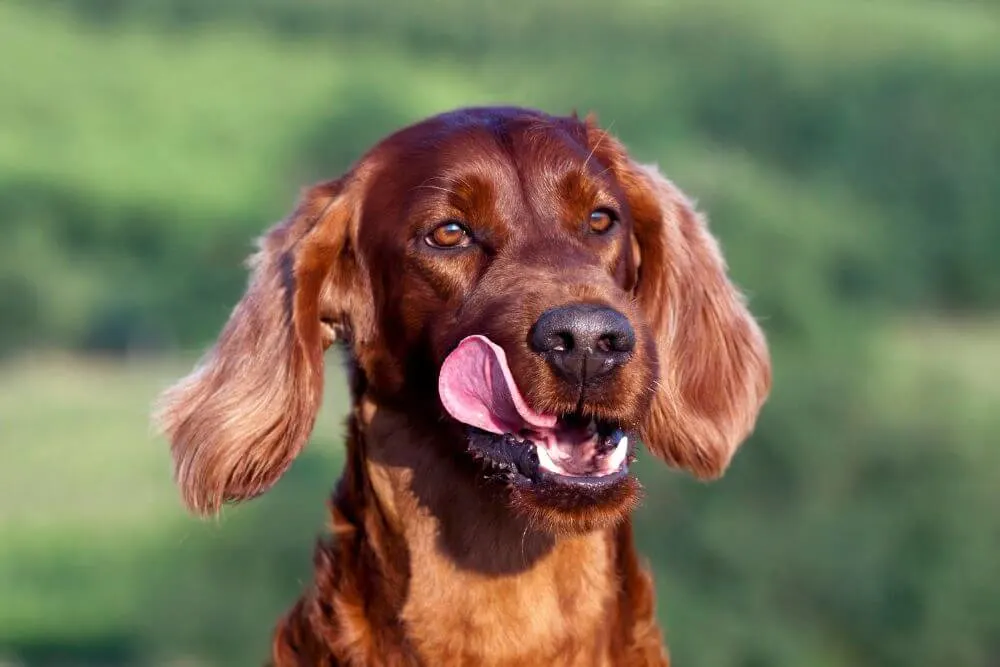
Irish Setters require balanced nutrition to maintain a fit and healthy lifestyle. Good quality dog food is very important. Depending on the dog’s age, the type of dog food may differ, so ensure that the food that you choose is age appropriate for their needs.
As this breed is known to suffer from bloat, it is advisable to plan the meal times well. In general, it is better to serve a few small sized meal portions rather than one or two bigger meals to Irish Setters. Consult your vet to make sure you get the amounts correct.
Dogs need a special gluten free diet if they are celiac.
How much exercise do Irish Setters need?

Irish Setters are an athletic dog breed, with plenty of energy and stamina, because of this, they need lots of exercise.
Roughly 1-2 hours a day of exercise is typically enough to keep their bodies and minds balanced.
If Irish Setters do not receive enough exercise, they tend to become depressed and even destructive.
Irish Setters enjoy running free and should be regularly allowed to do so in a secured fenced area, such as a dog park.
Long walks and runs are a good way to exercise with this breed, but as they are very social, they enjoy games such as fetch and frisbee with their owners.
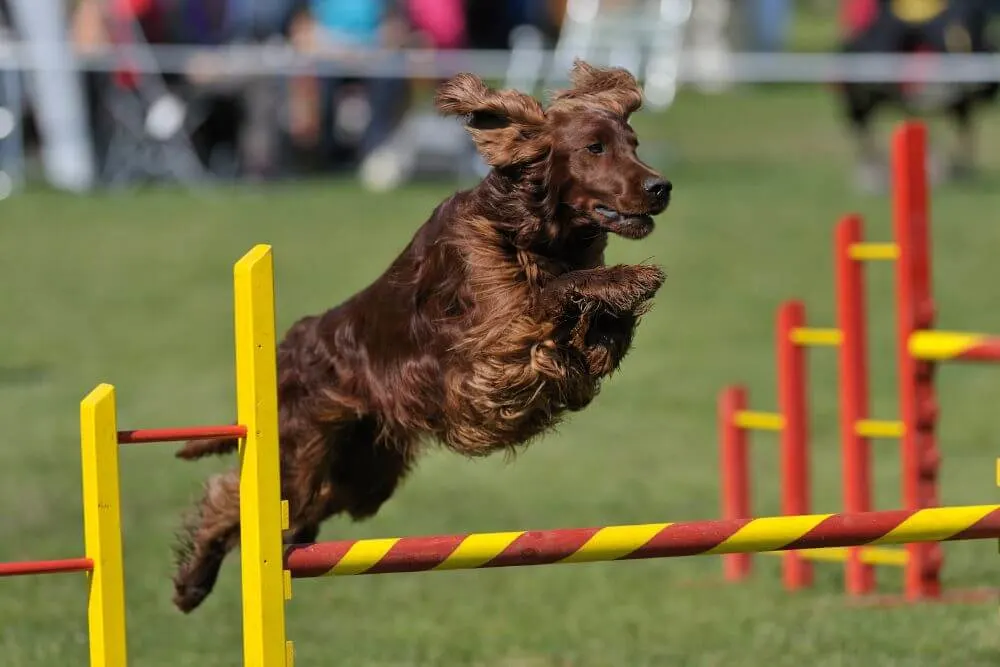
Canine sports such as agility, tracking and obedience trials are good outlets for this breed’s boundless energy.
An Irish Setter loves to be busy and enjoys having a task to complete, which makes them great candidates for dog sports.
Irish Red Setter puppies and young dogs may risk damaging their joints if they over exert themselves with strenuous activities such as running, jogging or accompanying their owners cycling.
It is best to wait until the dog is fully mature before attempting such exercise. It is also worth noting that while young dogs are very enthusiastic, they still don’t quite know their own limits and will often play themselves to exhaustion.
Do Irish Setters like to swim?
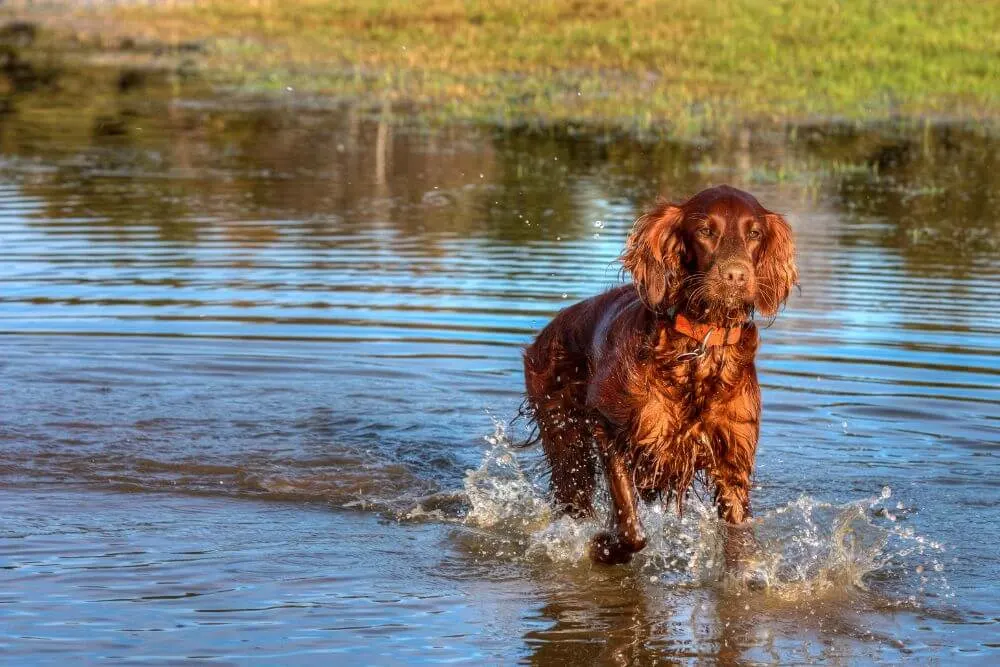
Yes, Irish Setters like to swim and enjoy being in the element of water, (although individual preferences can differ a little from dog to dog).
Irish Setters were bred to be multipurpose hunting dogs that would be useful in different terrains. While they were probably best suited to upland terrain, these dogs are actually quite good swimmers.
If you want to introduce your dog to the water, always start gradually to ensure the dog builds up its confidence and ability before taking to deeper water.
Always ensure that the area and local weather conditions are safe for swimming before allowing the dog to enter the water.
Is it easy to train an Irish Setter?
Irish Setters are very intelligent, quick to learn and stubborn.
This combination can make them a little tricky, but not impossible to train.
The key is clear, calm and consistent dog training from a very early age (roughly 8 weeks). The owner and trainer should be firm, but not harsh as this is a sensitive dog breed.
Lots of patience and time will also be needed to train an Irish Setter,
Known for being headstrong and being easily distracted by smells, these dogs need to have the right amount of challenge and difficulty in the training program to be engaged.
Short training sessions with a clear focus are usually the best approach. As this dog will learn both positive and negative behaviors quickly and be slow to forget either!
As these dogs can be quite excitable and not always predictable, it is best to make sure they are kept in a fenced area until they can be relied upon for their recall. This breed is known for “playing deaf”.
Early socialization will help to raise a puppy red setter into a well rounded adult dog able to deal with different circumstances, in addition to a range of encounters with both humans and animals.
Is an Irish Setter a smart dog?
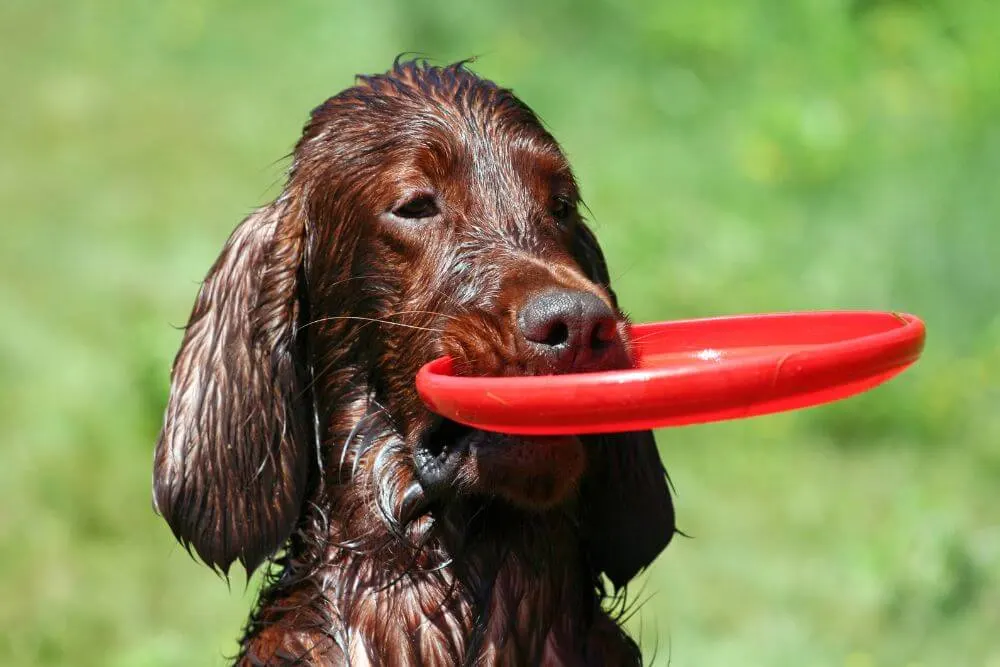
Irish Setters tend to mature slowly and have a longer puppy-like phase than many other dog breeds, however don’t be fooled, they are exceptionally smart dogs that need lots of mental stimulation.
Their independent streak can also be seen in their determined and sometimes inflexible behavior.
A balanced dog will have the right amount of input and outputs in terms of physical and mental exercise.
Irish Setters that are not getting enough stimulation, may be destructive and start chewing objects.
Are Irish Setters very vocal?
Irish Setters are a vocal dog breed and tend to bark a bit more than average.
They are not considered to be quiet dogs and for this reason, they are not suited to every home or even neighborhood.
However, this trait does come in useful if you are looking for a good watch dog.
Irish Setters Temperament and Personality
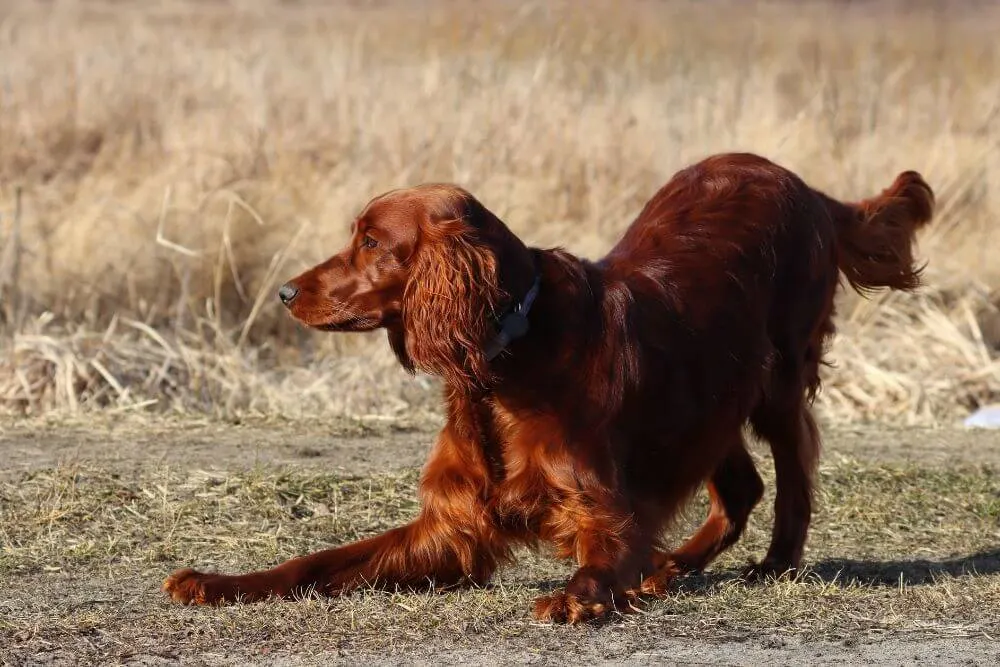
Irish Setters are fun loving dogs with boundless energy.
They are friendly and typically good natured in character, but be warned they definitely have a mischievous side as well. In terms of appearance, they radiate glamor and elegance and have a particular swank that has a model-like look to it.
As independent souls, they have an obstinate determination to get their own way, so early training will help to ensure that the dog has good discipline.
They are not usually particularly shy when it comes to meeting strangers and they are also not usually aggressive either.
(Although they do occasionally try to take a playful nip at people.)
Irish Setters are very much a social dog and enjoy the company of humans and thrive when around them and should be left alone for too long.
Their energetic nature is well suited to outdoorsy people who have very active lifestyles.
Whether you are interested in a skill hunting dog or a lovable family pet, the temperament and traits of the Irish Setter are well adapted to both.
Is an Irish Setter a good first dog?
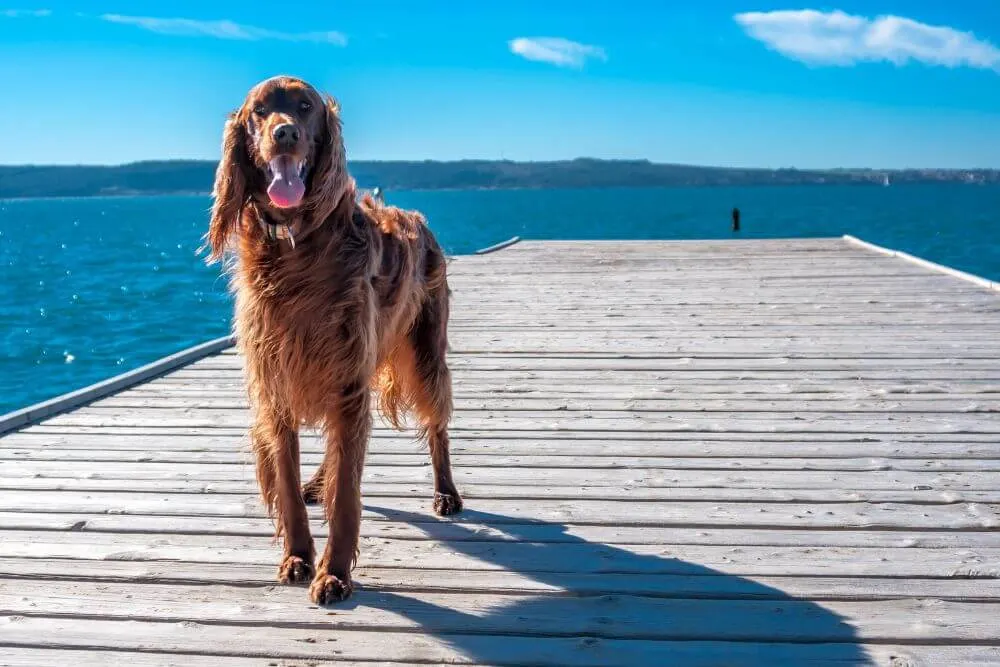
Why are Irish Setters not popular first time dogs?
Realistically, there are other breeds of dog other than an Irish Setter that would probably be an easier option for people with no experience with dogs.
Irish Setters have lots of energy, so making sure that the exercise needs of the dog are fulfilled every day is just one of the challenges in looking after this breed.
The stubborn side of this breed can make training Irish Setters a little challenging, so if you do not have any experience, you may soon feel out of your comfort zone and this could lead to Irish Setter behavior problems.
They also take a while to mature, so ample amounts of patience are required.
And lastly, the very attractive coat of the Irish Setter needs considerable pet care maintenance to stay in great shape.
While it is not the most tricky coat to manage, other breeds might be easier to start with.
Are Irish Setters good family dogs?
Yes, the affable nature of the Irish Setter temperament is well suited to family life and they make good family dogs for active people.
A spacious house is a much better option for an Irish Setter rather than a family apartment.
A home with a fenced in garden to run around in is the ideal option for these dogs.
They enjoy being indoors, but also need regular possibilities to stretch their legs.
Are Irish Setters good with kids?
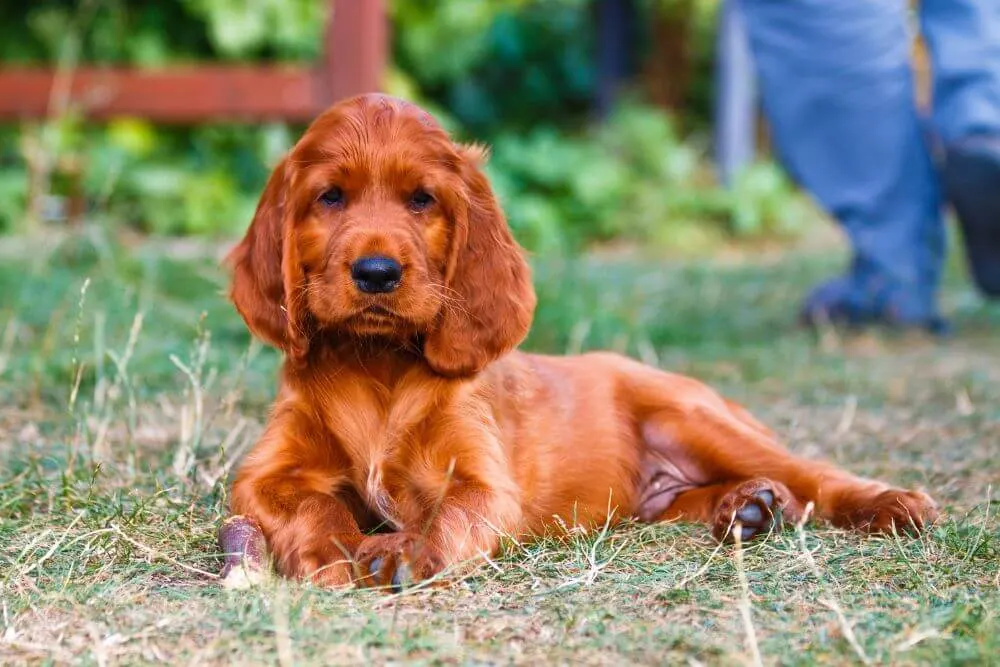
Older children make great playmates for Irish Setters.
They enjoy the company and the rough and tumble of childhood play.
Younger kids may be a bit overwhelmed by the Irish Setter size and boisterous nature of this dog breed from time to time so the breed is a better fit for families with older children.
As always, it is best to keep a supervised eye on any dog and children interactions, for the safety of all involved.
Are Irish Setters aggressive?
No, under normal circumstances, Irish Setters are not aggressive and have a friendly openness towards people. If threatened however, they can become protective.
Are Irish Setters good guard dogs?
Irish Setters make excellent watch dogs and are usually very alert and vocal when someone approaches.
Their typical nature is not particularly protective or aggressive so in terms of being a guard dog, this breed scores poorly due to its poor assertiveness.
Are Irish Setters good with other dogs?
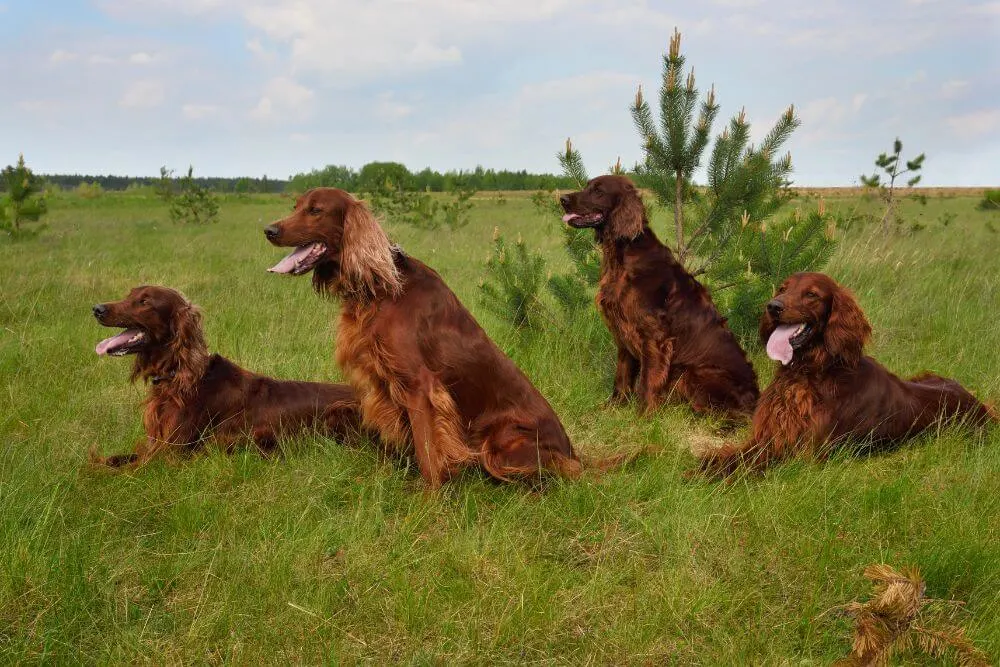
Very often Irish Setters tend to be a breed that is easy to get along with.
Dogs that have been socialized from an early age are likely to get along with other dogs without too many complications.
Are Irish Setters good with cats?
Whether an Irish Setter is good around cats depends on the individual dog, as well as the degree of its early exposure to smaller animals.
Irish Setters can certainly get along well with cats in some circumstances.
However, the natural instinct to catch smaller animals (including pets) is still strong in Irish Setters, so there should always be some supervision.
Do Irish Setters have a strong prey drive?
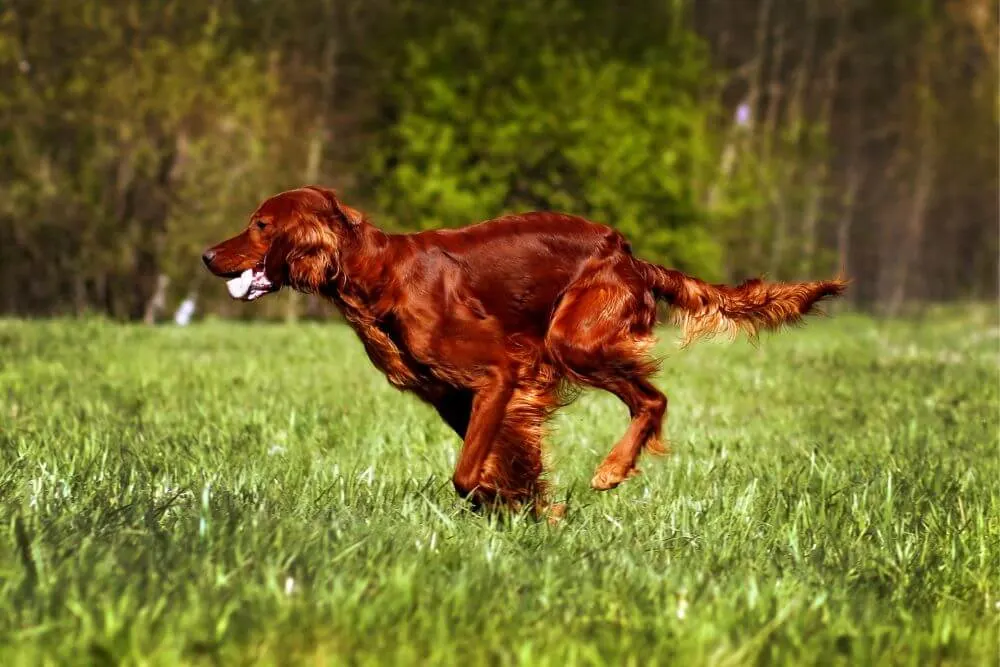
As the Irish Setter was primarily bred as a hunting dog for game birds, pet birds and Irish Setters do not tend to mix well and best to keep them separated at all times.
The strong instinct to locate prey also means that Irish Setters should be kept on a leash at all times in public spaces.
Particularly when they are younger they have poor recall and it is best not to trust them until they are fully trained.
Are Irish Setters rare?
While Irish Setters are not seen all that frequently, they are not considered rare.
In fact, the Irish Setter breed is only one of three Irish native species that is considered not to have a vulnerable status.
(In case you are wondering, the other two dog breeds are the Irish Wolfhound and the Irish Soft Coated Wheaten Terrier).
Of all the Irish native breeds, the Irish Setters are possibly the most well known and numerous around the world.
Irish Setter Breed Clubs
In 1882 the Irish Red Setter Club dedicated to the breed was founded in Dublin, Ireland.
A few years later, the first official breed standard based on a 100 point scale was created for the breed.
As the Irish Setter continued to grow in popularity, so did the number of breed clubs for this Irish dog type around the world.
The Irish Setter Club of America was founded in 1891 and has breed information on its website about different programs and events, as well as details about breeders and rescue dogs.
The Irish Setter UK and Ireland website has many events and activities listed on its page. It also features many other useful links to other more regional breed clubs for Irish Setters in the UK.
If you are looking to find out more about the breed, other clubs that might be useful to know about are the Irish Setter Club of Canada, Irish Setters Australia and the International Irish Red Setter Club.
Irish Setter Breeders

If you have decided to look for an Irish Setter puppy for sale then the first step to finding one is locating a reputable breeder.
It is important to do some research on different breeders and shop around to make sure that you are only opting for someone who is knowledgeable and has completed all of the necessary medical checks and certifications required for this breed.
Do not purchase an Irish Setter puppy from the first random Irish Setter puppies for sale advert that you see.
Before purchasing an Irish Setter puppy, it is important to have visited the facilities when the puppy was raised, view the mother and get detailed medical information (that has been independently verified) about the parents and other ancestry of the puppy.
Be prepared to ask plenty of questions about the Irish Setter puppies and if the breeder has the right intentions, they will also quiz you on your ability to care for an Irish Setter for life.
Breed clubs can be a good place to enquire about Irish Setter litters.
The major kennel clubs also usually have a marketplace advertising puppies for sale as well.
It is a good idea to also consult your local vet, who might also know about Irish Setters that might need new homes.
If you want to buy an adult dog rather than a puppy, this is also sometimes possible from breeders.
It is worth enquiring, if they have an adult Irish Setter for sale if this is the option that you think would suit you best.
Irish Setter Price
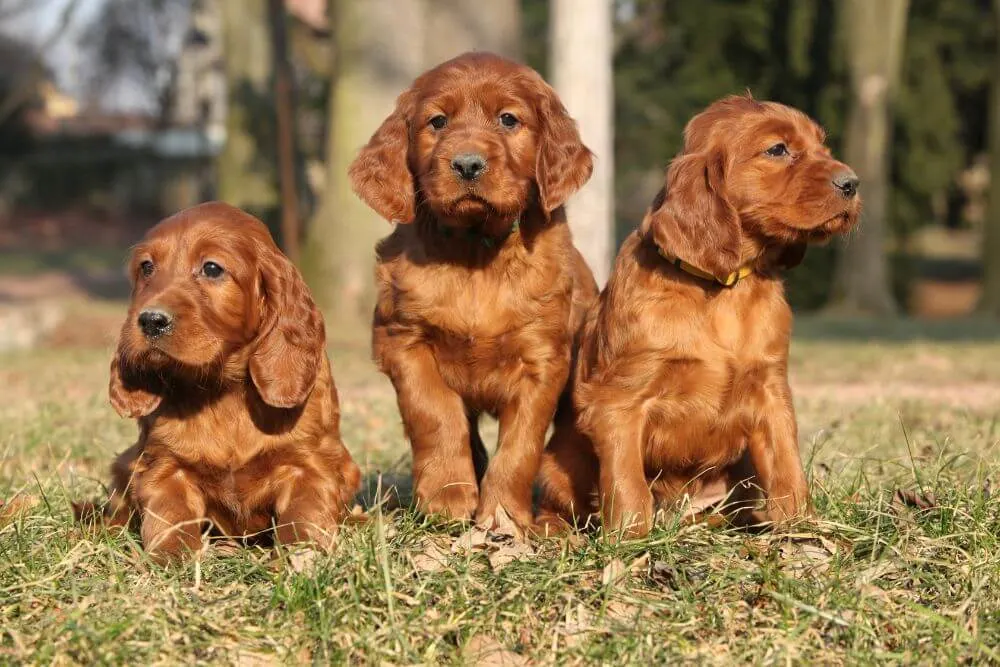
The price of an Irish Setter puppy varies and depends on several different factors.
Dogs that have champion bloodlines are going to be more expensive than those without.
The gender of the dog, as well as its location and the general availability of puppies are likely to also play a role in the price.
Potential owners should reckon with a price range of between US$1200-2500 for an Irish Setter puppy.
Irish Setter in Need and Irish Setter Adoption
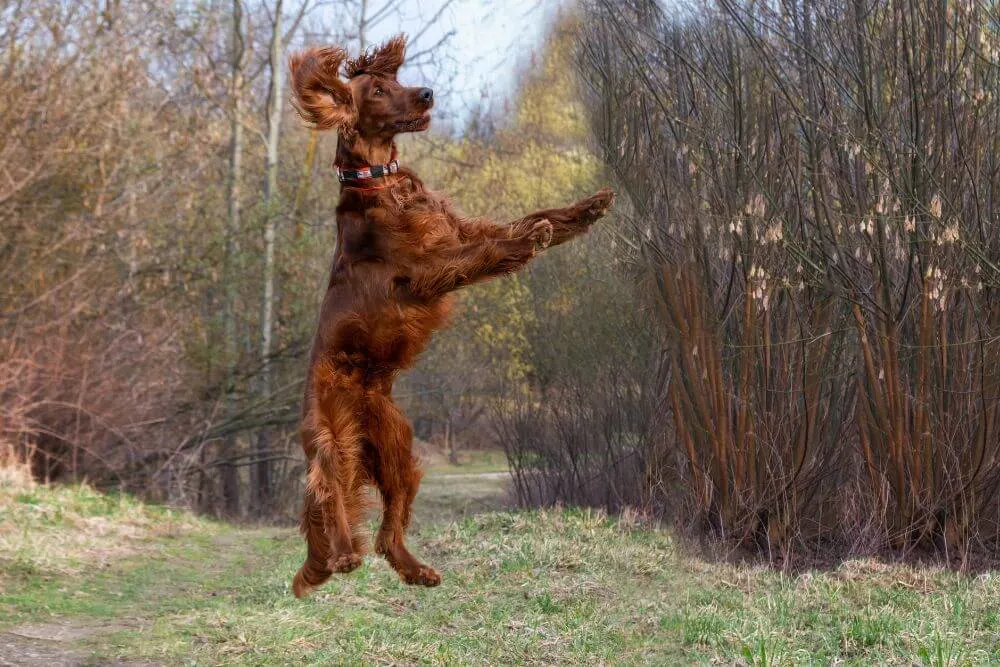
Irish Setters may need to be rehomed if they are not well suited to their owner or if there is a change in the circumstance of the owner, for example.
Nearly all of the breed clubs offer some kind of rescue and rehoming program. I
t is usually possible to enquire or else complete a form to be placed on the waiting list.
Most clubs ask for a donation to cover the costs incurred by rehousing and any medical bills.
It is important to know exactly what you are signing up for before opting for an adopted dog.
This dog is going to need stability and security, so be sure that you are able to provide that for the dog for the long term.
The History of the Irish Setter
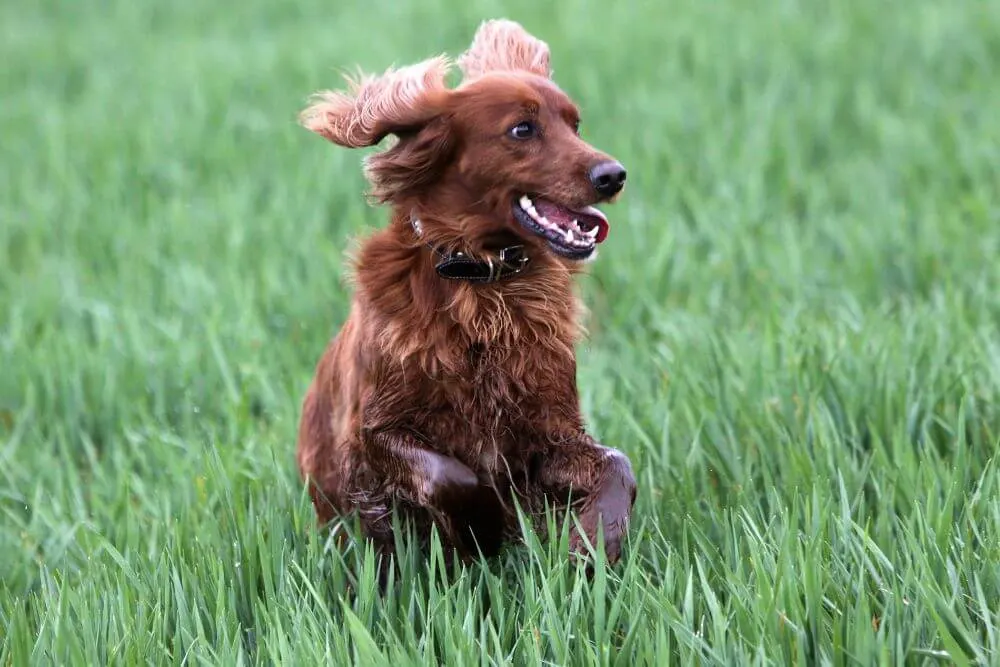
The Irish Setter is a dog breed that captured the eyes of the public with its stunning looks.
Irish Setters of Ireland in the 19th century were bred for their hunting abilities and not for the color of their coats.
These dogs were skilled hunters able to locate, point (direct) and when required, retrieve game birds for their owner.
However, when the public got a taste for the fiery looks of the Irish Setter red colored coat, the selective breeding focused almost entirely on the appearance rather than the hunting skill set of the breed.
The Origin of the Irish Setter
As with all native Irish dog breeds, it is difficult to pinpoint the exact origins of this breed.
It is thought to have some spaniel ancestry, but was also likely bred with English Setter, Welsh Springer Spaniels, English Cocker Spaniels and Gordon Setters through the generations.
The results were mixed colored red and white setters that were usually owned by the wealthier gentry classes in Ireland from about the 17th century.
Setters were used before the introduction of guns to help locate and track game birds.
After guns became more widespread, the ability of the setter to stay low and restrained when the hunter was about to take a shot ensured that they were still a very valuable asset for hunting.
During the 17th and 18th centuries there was still a large degree of interbreeding going on between setters with different colored coats.
Some of the landowners took a fancy to a type of the Irish Setters developed the type further.
For example, by around 1812, the Earl of Enniskillen bred almost completely red setters, while other families such as the Rossmore family of Monaghan focused on the red and white setters.
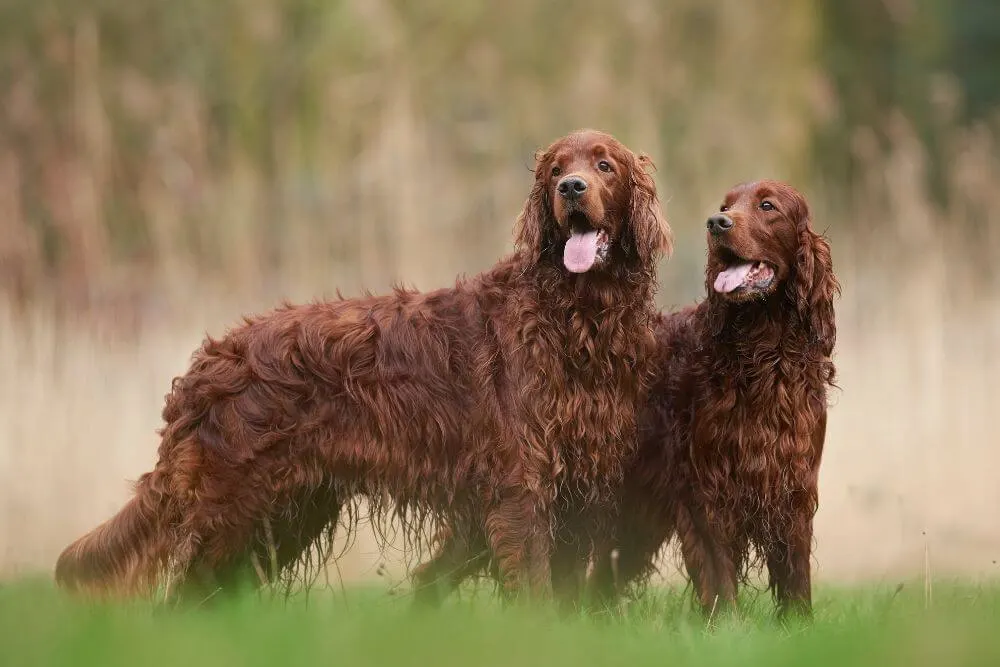
By about the 1870s, dog shows became more popular and so did the solid red – Setter.
Up until this point in time, the setter dog had been largely valued and prized on its hunting abilities, however the new focus on the dog in the show ring, rather than in the field, allowed for greater attention to detail in the appearance.
The glossy coat and the racy appearance of the Irish Setter, combined with its love of mischief captured the hearts of many and the popularity of this dog began to rise. This was the Irish Setter Irish people (and many more around the world) fell in love with.
However, the rise of this breed came at the expense of the Irish Red and White Setter, who became the forgotten cousin..
Infact, the Irish Setter (also widely referred to at the times as the Irish Red Setter) was recognised as a breed in the mid 1870s by the Kennel Club.
The American Kennel Club followed suit in 1878 and also recognized the breed. Ironically, the Irish Red and White Setter, which is presumed to be the main ancestor of the Irish Setter breed was only recognised as a breed itself in 1978 by the Irish Kennel Club and as late as 2009 by the AKC.
Irish Setter Hunting Dogs
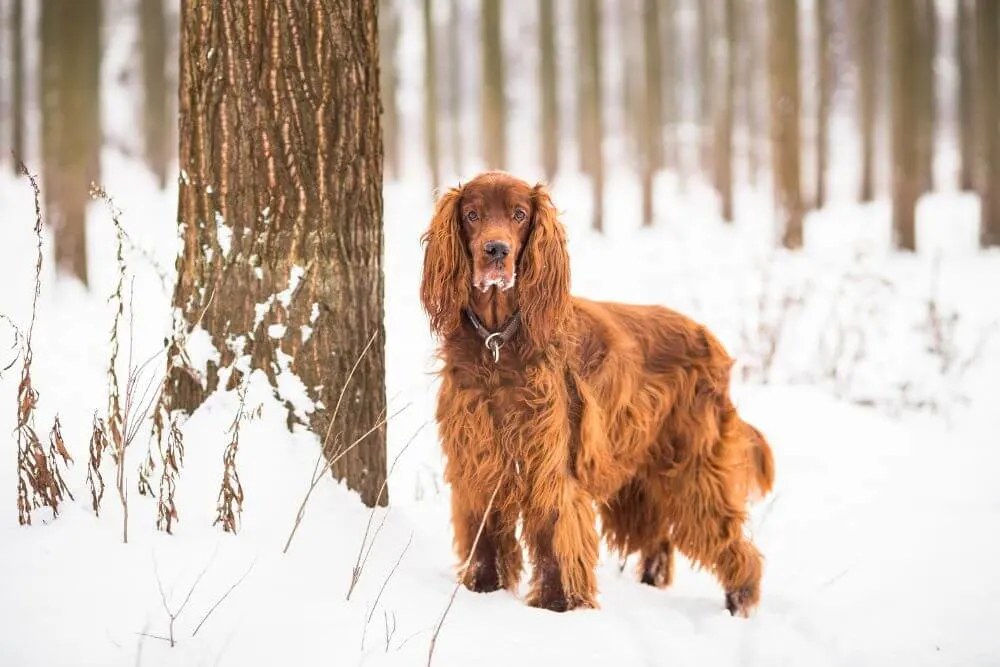
While initially, the general Setters from Ireland were praised for their exceptional skills in the field, after the focus turned to the looks of the all red Irish Setter, there seemed to be a decline in the ability of the breed in the field.
While they could perform as skilled companions for hunters, in most cases it was the Irish Red and White Setters, who won the championships.
(The focus of breeding Irish Red and White Setters stayed firmly in the direction of its abilities in the field as a working dog and not towards its aesthetics as a show dog.)
Attempts to recently improve the field skills of modern Irish Setters occurred through breeding programs that crossed with breeds such as English Pointers, English Setters and Brittany Spaniels.
After 5 generations of pure pedigree Irish Setter, these dogs are considered by the Field Dog Stud Book as true Irish Setters, but are generally referred to as Red Setters, to identify their breeding history.
Red Setters are typically smaller than Irish Setters and they tend to have a coat that is lighter in color and more dark brown or fawn in color compared with the deep red or mahogany of the Irish Setter coat colors.
Did you know? Actually the Irish Setter all red dogs were seen as having a slight disadvantage in the field because they were harder to see in the vegetation. Setters with some amount of white in their coat were more visible.
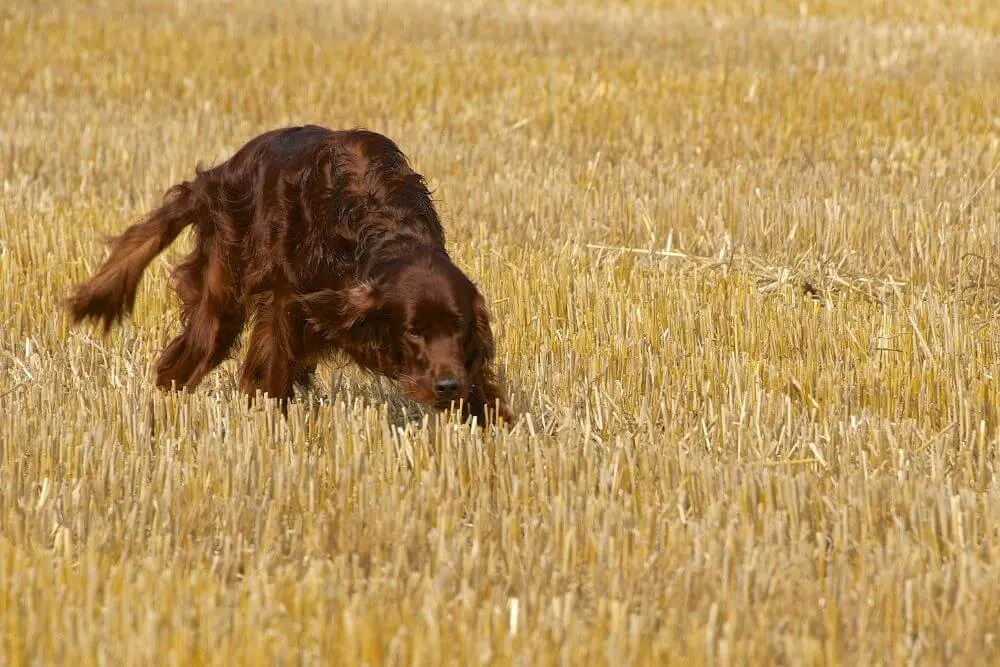
As a working dog, they scour the ground with their accurate sense of smell and follow a short zig-zag pattern as they quarter the area in search of their quarry.
Once the other quarry was located, the dog would hold a pointing position and indicate to the hunter the direction of the bird.
They are adapted to different environments and can either perform larger zig-zag patterns in open areas or shorter, tighter ones in more restricted areas such as woodlands.
Irish Setters are swift on their feet and very agile. Their boundless energy is an asset when hunting over rough terrain for several hours.
Did you know?
As well as the dog Irish Setter, Irish Setter is a popular brand of outdoor American footwear by the Red Wing Irish Setter Shoe Company.
In addition to the many different Irish Setter boots, there are also Irish Setter shoes.
Irish Setter Show Dog
From around the 1870s when solid red Irish Setters first started appearing at dog shows, their popularity grew.
Their glossy, feathered coats and graceful bodies caught the attention of the public, as well as the judges at dog shows.
Did you know?
The Big Red movie about an Irish Setter show dog was released by Disney in 1962.
One knock-on effect of the movie was the rise in the number of Irish Setters kept as pets, particularly in the United States for several years afterwards.
Native Irish Dog Breeds
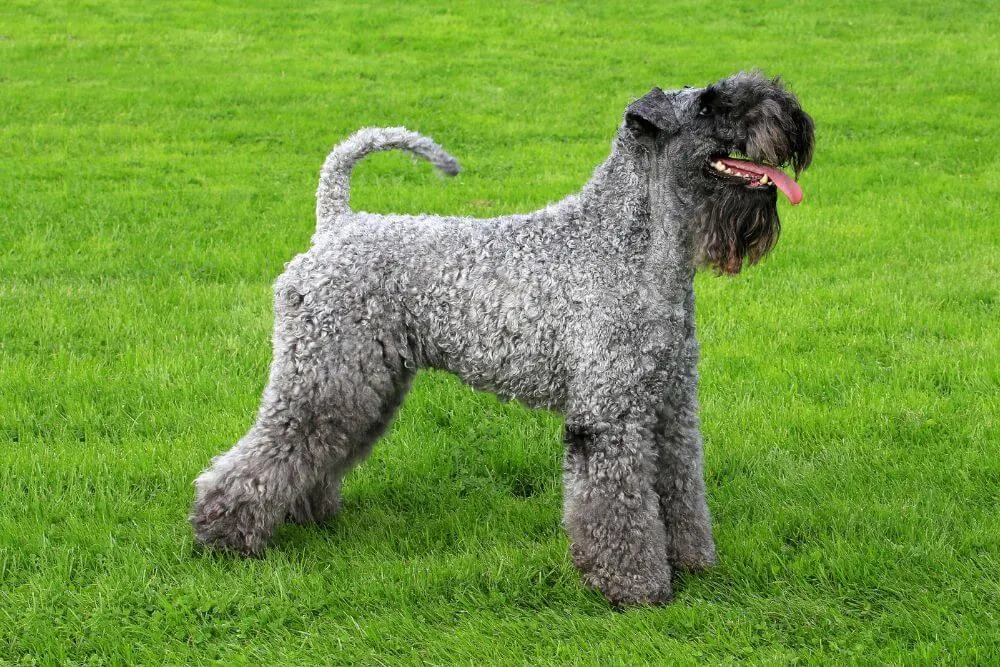
In total Ireland has 9 native Irish Dog breeds. Along with the large breed dog, the Irish Wolfhound, the Irish Setter is a very iconic dog breed from Ireland.
As well as the similar breeds Irish Setter and Irish Red and White Setter, there is one other Irish gundog, the Irish Water Spaniel.
More dog breed information about the 9 Irish dog breeds, including breed characteristics and all about the dog breeds Irish origins can be found here:
- Irish Red and White Setter
- Irish Water Spaniel
- Irish Wolfhound
- Kerry Beagle
- Irish Terrier
- Kerry Blue Terrier
- Irish Soft Coated Wheaten Terrier
- Glen of Imaal Terrier
For a shorter overview with the main points about each breed and a short introduction to their fascinating history, you should read the Guide to Irish Dog Breeds.
This article may contain affiliate links. If you click on one of these we may receive a small commission at no extra cost to you. Thank you for your support.
Please note that this article is only for general information purposes about the Irish Setter breed and should not be used as a substitute for canine health information, as well as medical and dog care advice from veterinary specialists.

(Irish Nature Expert and Celtic Enthusiast from Ireland)
Emer Walker, founder of LetsGoIreland.com, is a Cork native with profound expertise in Irish nature and ecology. Holding a PhD in Restoration Ecology and backed by extensive research in ecological sciences, she’s delved deep into Ireland’s natural wonders, from its rugged landscapes to its serene beaches. Emer’s passion also encompasses Celtic art and traditions. As a true authority on Ireland’s natural and cultural heritage, she invites readers through LetsGoIreland.com to immerse themselves in the authentic Irish experience.
